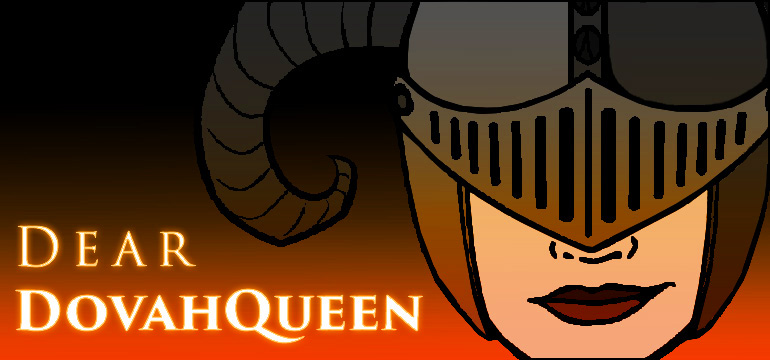Do you run your game in a sandbox or does your story run on rails? Today, we shine a light on some of the struggles of both GMing styles and look at some ways to get the best of both worlds.
Dear DovahQueen: What’s your opinion on living worlds (places where you could run into stuff that’s way outside your power level due to realism), and worlds on wheels, where everything’s scaled to the player’s levels and abilities?—Living Conductor
Dear Liv Con: Both world themes are commonly used by GMs because they address certain issues that tend to show up again and again in games. The world of wheels style tends to be ran with intention of a heavy story, because some players often are seeking stronger story than a simple smash-and-grab for justice. The living world style tends to have more emphasis on capturing the way things work in our world, because other players are seeking more gritty realism in their game than the common fantasy tropes that have come to define the genre.
The world on wheels, or a railroad as we call it in our group, is created by a GM who strives to tell a story above all else. GMs prepare these stories specifically for the players much in the same way a grandmother prepares a holiday meal for her family. Both carefully plan and craft their product with the intimate knowledge of the people who will partake of it. The chief complaint players often have about this kind of game is that they feel like their choices and decisions have little impact on the story around them. My personal critique of this model is that players often cease to fear death or failure. Heroes know that they have plot armor, and thus make decisions to throw themselves headlong into the fray with the knowledge that their GM prepared this with a specific goal in mind and they probably won’t allow an impromptu player death to ruin their narrative. This game loses the edge of your seat fear that comes with that uncertainty. Gone is the inner voice that makes the player ask themself, “Maybe I should run away if I want to survive this.” But, for all its flaws, railroading the players allows a creative GM to craft an engaging story with plot twists, drama, and exciting scenes that would normally be difficult to accomplish in a less structured game.
The living world, or sandbox world, can best be summed up with “a lot of things live in the world, and not all of them are something you can beat in a fight.” This GM is more like the manager of a buffet restaurant. No less carefully, the GM plans a smorgasbord of adventure for their patrons. In these games, it’s up to the consumer to understand how much they can handle on their plate. This gives players more room to succeed or fail by their own decisions, but a common complaint of this model is that sometimes players struggle to find direction in the game. They often feel like the story was either weak or nonexistent, and a lot of times that’s true because it’s easier to allow players to affect the story when your story isn’t all that rigid in the first place. One of the strengths of the sandbox is that the player’s choices are put at the forefront of the game and they’re forced to confront the consequences of their actions. Thus, when a hero earns a win against a stronger opponent through planning, diligence, and patience, they know it’s a win that they earned and not one that was handed to them.
Both models have some valuable strengths and some valid criticisms. For the past few years, I’ve been focusing on a way to blend the pros of both while trying to minimize or remove the cons. I won’t pretend to say that I have a perfect formula, but my current model has been working pretty well in our games. I tend to write the cities and their cultures first when I’m planning a campaign. The major NPCs and their motivations come second. Then I finish by figuring out how to put all of this in front of the players using the backstories and motivation that they created for their characters. NPCs, henchmen, monsters, and villains that populate my world very much follow the living world model since I assign them HD and class levels that I feel best represent who they are and how much experience they have had in the setting rather than something that is comparable to the PCs. The same goes for bandits, commoners, bar fighters, and guard of each individual town. Since veteran players are unaccustomed to GMs that won’t pull punches, I tend to begin each and every session with a warning to my players to keep their own experience and station in the game’s setting in mind. I don’t craft encounters with the desire for them to win or lose, and I allow the plot to create itself depending on the outcome. Maybe they’ll defeat the bandits. Maybe the PCs will recognize that they’re outmatched and surrender. Maybe they’ll choose to fight to the death (because for some reason players seem to forget that there are other options). In this way, the events between forces within the story that occur are very on-the-rails scripted, but I haven’t limited the player’s eminence on their own unique story. They live or die based on the way they individually choose to interact with the encounter. The plot can move forward in the next session regardless of player choice because I know who my NPCs are, what they want, how they plan to get what they want, and I can figure out how they’ll respond to the PCs’ actions.
This has been working for myself and my group quite well, but that’s largely because I know my group and I make an effort to be responsive to want they’ve liked and what they haven’t. I’m also sure that my method will continue to evolve and adapt in response to player feedback because in the end, it’s more their story than it is mine. The chef may have made the meal, but it is the patrons’ to own and do with as they choose.
You can request RPG advice or send your questions by email to deardovahqueen@gmail.com or on Facebook.






